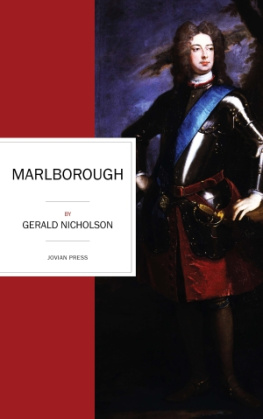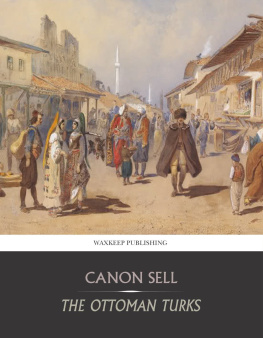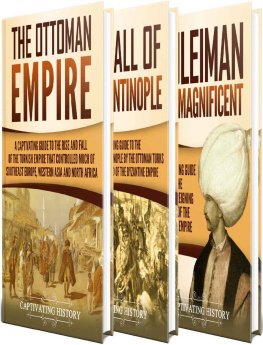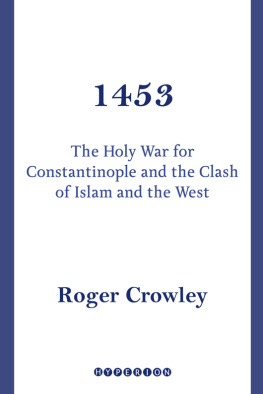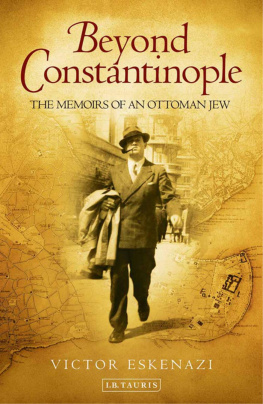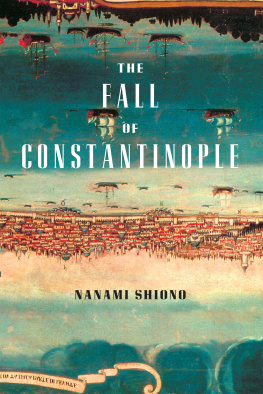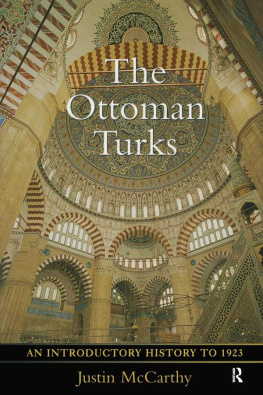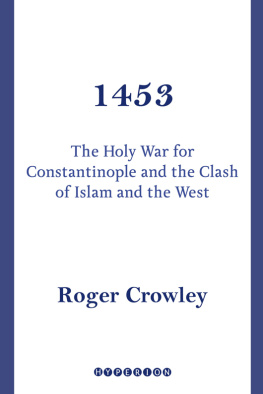Edwin Pears - The Ottoman Turks to the Fall of Constantinople
Here you can read online Edwin Pears - The Ottoman Turks to the Fall of Constantinople full text of the book (entire story) in english for free. Download pdf and epub, get meaning, cover and reviews about this ebook. publisher: Pronoun, genre: Detective and thriller. Description of the work, (preface) as well as reviews are available. Best literature library LitArk.com created for fans of good reading and offers a wide selection of genres:
Romance novel
Science fiction
Adventure
Detective
Science
History
Home and family
Prose
Art
Politics
Computer
Non-fiction
Religion
Business
Children
Humor
Choose a favorite category and find really read worthwhile books. Enjoy immersion in the world of imagination, feel the emotions of the characters or learn something new for yourself, make an fascinating discovery.
- Book:The Ottoman Turks to the Fall of Constantinople
- Author:
- Publisher:Pronoun
- Genre:
- Rating:4 / 5
- Favourites:Add to favourites
- Your mark:
- 80
- 1
- 2
- 3
- 4
- 5
The Ottoman Turks to the Fall of Constantinople: summary, description and annotation
We offer to read an annotation, description, summary or preface (depends on what the author of the book "The Ottoman Turks to the Fall of Constantinople" wrote himself). If you haven't found the necessary information about the book — write in the comments, we will try to find it.
Edwin Pears: author's other books
Who wrote The Ottoman Turks to the Fall of Constantinople? Find out the surname, the name of the author of the book and a list of all author's works by series.
The Ottoman Turks to the Fall of Constantinople — read online for free the complete book (whole text) full work
Below is the text of the book, divided by pages. System saving the place of the last page read, allows you to conveniently read the book "The Ottoman Turks to the Fall of Constantinople" online for free, without having to search again every time where you left off. Put a bookmark, and you can go to the page where you finished reading at any time.
Font size:
Interval:
Bookmark:
OSMAN. 1299-1322
IT was in 1299 that Osman (Othmain, Uthman) declared himself Emir of the Turks, that is, of the tribe over which he ruled. The Seljuq Turks have been treated in a previous chapter; but there were many other Turkish tribes present in the middle and at the end of the thirteenth century in Asia Minor and Syria, and, in order to understand the conditions under which the Ottoman Turks advanced and became a nation, a short notice of the condition of Anatolia at that time is necessary. The country appeared indeed to be everywhere overrun with Turks. A constant stream of Turkish immigrants had commenced to flow from the south-west of Central Asia during the eleventh century, and continued during the twelfth and indeed long after the capture of Constantinople. Some of these went westward to the north of the Black Sea, while those with whom we are concerned entered Asia Minor through the lands between the Persian Gulf and the Black Sea. They were nomads, some travelling as horsemen, others on foot or with primitive ox-waggons. Though they seem to have left Persia in large bodies, yet, when they reached Anatolia, they separated into small isolated bands under chieftains. Once they had obtained passage through Georgia or Armenia or Persia into Asia Minor, they usually turned southwards, attracted by the fertile and populous plains of Mesopotamia, though they avoided Baghdad so long as that city was under a Caliph. Thence they spread through Syria into Cilicia, which was then largely occupied by Armenians under their own princes, and into Egypt itself. Several of these tribes crossed the Taurus, usually through the pass known as the Cilician Gates, and thereupon entered the great tableland, three thousand feet above sea-level, which had been largely occupied by the Seljaqs. By 1150, the Turks had spread over all Asia Minor and Syria. These early Turks were disturbed by the huge and well-organised hordes of mounted warriors and foot-soldiers under Jenghiz Khan, a Mongol belonging to the smallest of the four great divisions of the Tartar race, but whose followers were mainly Turks. The ruin of the Seljuqs of Rum may be said to date from the great Mongol invasion in 1242, in which Armenia was conquered and Erzerum occupied. The invading chief exercised the privilege of the conqueror, and gave the Seljuq throne of Rum to the younger brother of the Sultan instead of to the elder. The Emperor in Constantinople supported the latter, and fierce war was waged between the two brothers. A resident, somewhat after the Indian analogy, was appointed by the Khan of the Mongols to the court of the younger brother. The war contributed to the weakening of the Seljuqs, and facilitated the encroachment of the nomad Turkish bands, who owned no master, upon their territory. The Latin occupation of Constantinople (1204-1261) had the same effect, for the Latin freebooters showed absolutely no power of dealing with the Turks, their energies being engaged simply in making themselves secure in the capital and a portion of its European territory. Hulagu, the grandson of Jenghiz Khan, captured Baghdad in 1258 and destroyed the Empire of the Caliphs. He extended his rule over Mesopotamia and North Syria to the Mediterranean. The dispersion of the new Turkish hordes not only greatly increased the number of nomads in Asia Minor, but led to the establishment of additional independent Turkish tribes under their own rulers, or emirs, and to an amount of confusion and disorder in Asia Minor such as had not previously been seen under the Greek Empire. The chieftain and his tribe usually seized a strong position, an old fortified town for example, held it as their headquarters, refused to own allegiance to the Emperor or any other than their immediate chieftain, and from it as their centre plundered the inhabitants of the towns and the neighbouring country. The tribes showed little tendency to coalesce. Each emir fought on his own account, plundered on all the roads where travellers passed, or demanded toll or ransom for passage or release. In this want of cohesion is to be found one explanation of the fact that though the Turks were defeated one day, yet they emerge with apparently equal strength a short time after in another place. They had to be fought in detail in their respective centres or as wandering tribes. During the thirteenth century many such groups of Turks occupied what a Greek writer calls the eyes of the country. Even as far south as Aleppo there was such an occupation by a tribe with a regular Turkish dynasty. Some such chiefs, established on the western shores of the Aegean, not only occupied tracts of country, but built fleets and ravaged the islands of the Archipelago. During the half century preceding the accession of Osman, Tenedos, Chios, Samos, and Rhodes fell at various times to these Turkish tribes. Some of them, who had occupied during the same period the southern and western portions of the central highland of Asia Minor, met with great success. Qaraman established his rule around the city of Qaraman, whose strongly fortified and interesting castle still stands, a noble ruin, on the plain about sixty-four miles south-east of Qonya. But the same Qaraman ruled over a district extending for a time to the north-west as far as, and including, Philadelphia. Indeed, he and his successors were for perhaps half a century the most powerful Turks in Asia Minor. Other chiefs or emirs ruled in Germiyan, at Attalia, at Tralles, now called after its emir Aidin, and at Magnesia. The shores of the Aegean opposite Lesbos and large strips of country on the south of the Black Sea were during the same period under various Turkish emirs. The boundaries of the territories over which they ruled often changed, as the tribes were constantly at war with each other or in search of new pasture. Needless to say, the effect of the establishment of so many wandering hordes of fighting men unused to agriculture was disastrous to the peaceful population of the country they had invaded. The rule of the Empire in such districts was feeble, the roads were unsafe, agriculture diminished, and the towns decayed. The nomad character of these isolated tribes makes it impossible to give a satisfactory estimate of their numbers on the accession of Osman. The statements of Greek and Turkish writers on the subject are always either vague or untrustworthy.
Three years before Osman assumed the title of emir, namely in 1296, Pachymer reports that the Turks had devastated the whole of the country between the Black Sea and the territory opposite Rhodes. Even two centuries earlier similar statements had been made. For example, William of Tyre after describing Godfrey of Bouillons siege of Nicaea in 1097 says the Turks lost 200,000 men. Anna Comnena tells of the slaughter of 24,000 around Philadelphia in 1108; four years later a great band of them were utterly destroyed. Matthew of Edessa in 1118 describes an innumerable army of Turks as marching towards that city. It would be easy to multiply these illustrations. The explanation is to be found in the nomadic habits of the invaders, and in the fact already noted that there was a constant stream of immigration from Asia.
The tribe over which Osman ruled was one which had entered Asia Minor previous to Jenghiz Khans invasion. His ancestors had been pushed by the invaders southward to Mesopotamia, but like so many others of the same race continued to be nomads. They were adventurers, desirous of finding pasturage for their sheep and cattle, and ready to sell their services to any other tribe. The father of Osman, named Ertughril, had probably employed his tribe in the service of the Sultan Ala-ad-Din of Rum, who had met with much opposition from other Turkish tribes. According to Turkish historians, he had surprised Maurocastrum, now known as Afyon-Qara-Hisar, a veritable Gibraltar rising out of the central Phrygian plain about one hundred miles from Eski-Shehr. Ertughrils deeds, however, as related in the Turkish annals, are to be read with caution. He became the first national hero of the Turks, was a Ghazi, and the victories gained by others are accredited to him. They relate that he captured Bilijik, Aq-Gyul (Philomelium), Yeni-Shehr, Lefke (Leucae), Aq-Hisar (Asprocastrum), and Give (Gaiucome).
Font size:
Interval:
Bookmark:
Similar books «The Ottoman Turks to the Fall of Constantinople»
Look at similar books to The Ottoman Turks to the Fall of Constantinople. We have selected literature similar in name and meaning in the hope of providing readers with more options to find new, interesting, not yet read works.
Discussion, reviews of the book The Ottoman Turks to the Fall of Constantinople and just readers' own opinions. Leave your comments, write what you think about the work, its meaning or the main characters. Specify what exactly you liked and what you didn't like, and why you think so.

